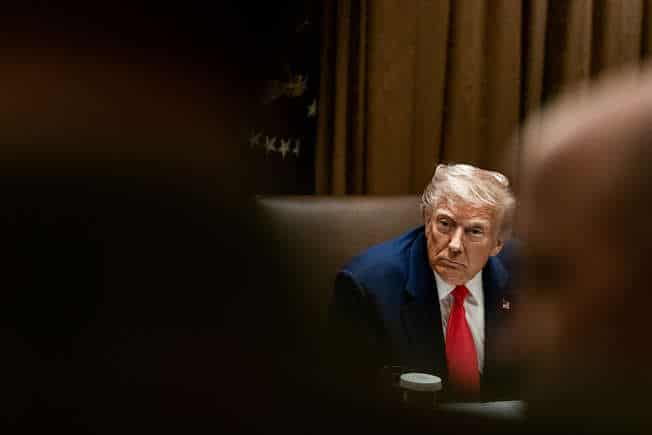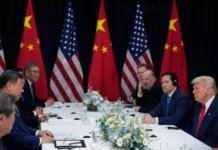A 10-point socialist breakdown of weeks of global economic turmoil
Per-Ake Westerlund, ISA International Political Committee
(This article was first published on 14 April 2025)
The world is witnessing a global power struggle. That’s the explanation for Donald Trump’s declaration of a trade war, with extreme tariff walls erected, and China as the main target.
A week after his massive “Liberation Day” attack, Trump was forced into several retreats, announcing “pauses” and exceptions. He did so with stocks, bonds and currency markets in freefall, making a deep financial crisis imminent.
But despite these retreats, tariff walls are still at record levels and imperialist antagonisms have intensified.
1. Liberation Day was a declaration of war
‘This is an act of war against the whole world,’ Martin Wolf observed in the Financial Times after Donald Trump’s “Liberation Day” ceremony on 2 April. This is an accurate description of the aggressive imperialism and neocolonialism Trump represents. The extreme tariffs were justified on the grounds of US ‘national security’. US citizens were urged to be prepared to make sacrifices at the outset of the confrontation in order to reap the benefits later.
It was not primarily a question of trade, but of establishing who is in charge. Especially in relation to Chinese imperialism, but also to the EU and the rest of the world.
That’s why the economists’ objections didn’t stop the juggernaut. These included those who warned that the tariff walls of the 1930s had led to depression, and those who showed that US imperialism’s trade deficits had in fact allowed it to live beyond its means.
2. Chaos and appeals
The first reaction of politicians and capitalists was shock. Despite all Trump’s election speeches, they did not believe he would go this far. The long list of tariff walls against the world’s countries was a mixture of a nightmare and a grotesque comedy.
The stock market crash followed immediately, wiping out thousands of billions of dollars of value. This led to deep anxiety about the global economy, jobs and pension funds. Export industries in many countries held their breath. The governments of Taiwan and Vietnam were among those who promised to reduce their tariffs against the US to zero. However, the EU’s offer to cut industrial tariffs to zero was met with the response that it was “not enough”.
The first reaction from the White House to the wave of panic was that ‘there will be no negotiations’ . Then, talks with Japan and South Korea were announced.
3. Financial system close to collapse
“The financial system came perilously close to the brink’ proclaimed a headline in The Economist. It was not just stocks that plummeted. US government bonds, which had acted as safe haven and risen during every stock market crash since 1987 (except during COVID), also began to fall in value. More than US$ 27 trillion worth of government securities were sold in a matter of days. Japan was among the sellers, and concerns grew that China, which has very large holdings of US debt, would also start selling up. As a result, the dollar also fell, by 4 percent in a few days.
Large capitalist hedge funds sold both government securities and gold to get cash to cover their debts. One billionaire commented that he feared ‘something worse than a recession’.
4. Fiasco — not ‘according to plan’
After a week, Trump was forced to retreat. His subservient staff immediately said that this happened ‘according to plan’. But even Trump himself referred to ‘people getting yippy’ to explain his decision.
The record “reciprocal” tariffs, allegedly in retaliation against other countries’ tariffs and “non tariff barriers”, were paused for 90 days. For all but China, where the level finally (?) ended up at 145 percent.
However, the 10% global basic tariff was maintained, as well as 25% on steel, cars and aluminium. Trump’s administration also announced that more special tariffs on pharmaceuticals and semiconductors are to come later.
This was a complete fiasco for Trump. If it was the case, as he claimed dubiously, that the paused tariffs would attract industries to the US, then the pause must surely also have paused this, or stopped it altogether.
Even after the withdrawal, US tariffs will average 20 percent, up from 3 percent, which is estimated to increase prices for an American household by the equivalent of US$ 4,700 per year.
5. China’s response and US escalation
The Chinese regime responded to the tariffs with corresponding increases, taking tariffs against US imports to a total of 124%. Tariff walls on both sides now mean that trade will plummet towards zero. The decoupling between the world’s biggest economies, which was already underway, is accelerating.
China is simultaneously shaken by a deep economic crisis and is totally dependent on exports. Though its dependence on the US market has decreased, a trade war could also hit exports to the EU and South-East Asia.
However, Beijing also has several strong cards, including its large holdings of US Treasuries, which have financed the US deficit, and its dominance in the refining of rare earths. The battle for minerals worldwide will intensify.
6. New exemptions
Just days after Trump’s 90-day pause, the next retreat came in the form of widespread exemptions. Mobile phones and other electronics would not be included in the high tariffs against China, but rather “only” be hit by the 20 percent tariffs announced some weeks ago. Mobile phones are the most important export product from China to the US, accounting for a tenth of total exports of $440 billion. This meant a lot to the Apple corporation, which has 80 percent of its production in China. But shortly afterwards, a new announcement was made that phones and other electronics will be included in the special semiconductor tariffs which are on the way.
7. Undermined dollar and confidence
‘Fear is everywhere,’ commented Stéphane Boujnah, head of the Paris-based Euronext, adding “the US is unrecognisable, we are living in a time of transition”. Trump will have huge problems restoring any kind of trust from the markets, if he even cares.
Trump’s plans so far mean that the US deficit and debt will rise sharply. This comes alongside warnings of recession and rising inflation.
The big crises of the 21st century — the financial crash of 2008–09 and COVID — have been prevented from becoming even deeper thanks to the intervention of central banks, especially the US Federal Reserve. This could well be the case again now if central banks step in, even though this would increase both debt and inflation.
8. 90 negotiations?
The White House parrots are now claiming that Mr Trump will participate in negotiations with 90 countries, which are lining up to reach agreements with US imperialism. No list of the governments that have asked for this — previously said to be 75 — has been presented. Uncertainty remains.
It is unclear whether so many negotiations will take place and what the outcome will be. The EU has already rejected demands from the Trump administration to eliminate VAT on US imports, tear up environmental rules and more.
At the same time, the EU and others are frantically seeking alternative trading partners, from ASEAN (10 states in Southeast Asia), the Gulf states, Mercosur in Latin America, etc. But these negotiations also face many national obstacles.
9. Trump far from his goals
After all his retreats, Trump has lost the momentum of ‘Liberation Day’ and the method he used then can not simply be reproduced.
More and more forecasts point to the US being in an economic downturn. This, coupled with rising prices, inflation, is known as stagflation, a serious condition for the capitalist economy.
On top of this, there is the threat of a currency war, where countries devalue to gain advantages for their exports. All in all, trade will decline.
10. Trump — symbol of capitalism
The Trump regime of parliamentary Bonapartism (one person’s repressive “strong man” rule) is a symbol of the deep crises of capitalism, both economic and political. Its reactionary policies are a sign of desperation. Decisive for the future is the resistance from below, working class action, struggle, strikes and mass movements, which can place socialist change on the agenda in place of Trumpist reaction.




